Environmental Engineering Structure Case Study 2022
VerifiedAdded on 2022/10/12
|15
|5483
|16
AI Summary
Contribute Materials
Your contribution can guide someone’s learning journey. Share your
documents today.
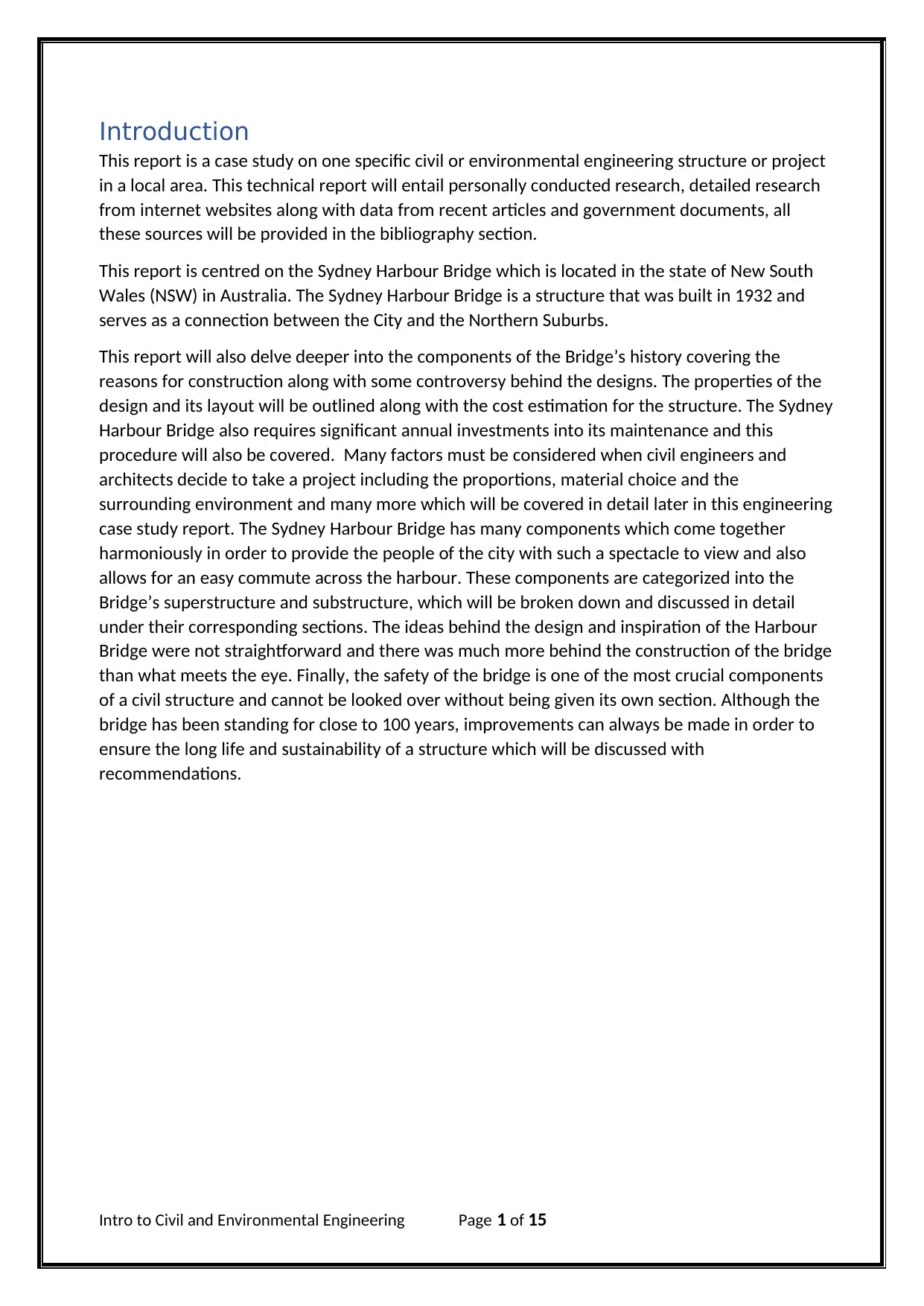
Introduction
This report is a case study on one specific civil or environmental engineering structure or project
in a local area. This technical report will entail personally conducted research, detailed research
from internet websites along with data from recent articles and government documents, all
these sources will be provided in the bibliography section.
This report is centred on the Sydney Harbour Bridge which is located in the state of New South
Wales (NSW) in Australia. The Sydney Harbour Bridge is a structure that was built in 1932 and
serves as a connection between the City and the Northern Suburbs.
This report will also delve deeper into the components of the Bridge’s history covering the
reasons for construction along with some controversy behind the designs. The properties of the
design and its layout will be outlined along with the cost estimation for the structure. The Sydney
Harbour Bridge also requires significant annual investments into its maintenance and this
procedure will also be covered. Many factors must be considered when civil engineers and
architects decide to take a project including the proportions, material choice and the
surrounding environment and many more which will be covered in detail later in this engineering
case study report. The Sydney Harbour Bridge has many components which come together
harmoniously in order to provide the people of the city with such a spectacle to view and also
allows for an easy commute across the harbour. These components are categorized into the
Bridge’s superstructure and substructure, which will be broken down and discussed in detail
under their corresponding sections. The ideas behind the design and inspiration of the Harbour
Bridge were not straightforward and there was much more behind the construction of the bridge
than what meets the eye. Finally, the safety of the bridge is one of the most crucial components
of a civil structure and cannot be looked over without being given its own section. Although the
bridge has been standing for close to 100 years, improvements can always be made in order to
ensure the long life and sustainability of a structure which will be discussed with
recommendations.
Intro to Civil and Environmental Engineering Page 1 of 15
This report is a case study on one specific civil or environmental engineering structure or project
in a local area. This technical report will entail personally conducted research, detailed research
from internet websites along with data from recent articles and government documents, all
these sources will be provided in the bibliography section.
This report is centred on the Sydney Harbour Bridge which is located in the state of New South
Wales (NSW) in Australia. The Sydney Harbour Bridge is a structure that was built in 1932 and
serves as a connection between the City and the Northern Suburbs.
This report will also delve deeper into the components of the Bridge’s history covering the
reasons for construction along with some controversy behind the designs. The properties of the
design and its layout will be outlined along with the cost estimation for the structure. The Sydney
Harbour Bridge also requires significant annual investments into its maintenance and this
procedure will also be covered. Many factors must be considered when civil engineers and
architects decide to take a project including the proportions, material choice and the
surrounding environment and many more which will be covered in detail later in this engineering
case study report. The Sydney Harbour Bridge has many components which come together
harmoniously in order to provide the people of the city with such a spectacle to view and also
allows for an easy commute across the harbour. These components are categorized into the
Bridge’s superstructure and substructure, which will be broken down and discussed in detail
under their corresponding sections. The ideas behind the design and inspiration of the Harbour
Bridge were not straightforward and there was much more behind the construction of the bridge
than what meets the eye. Finally, the safety of the bridge is one of the most crucial components
of a civil structure and cannot be looked over without being given its own section. Although the
bridge has been standing for close to 100 years, improvements can always be made in order to
ensure the long life and sustainability of a structure which will be discussed with
recommendations.
Intro to Civil and Environmental Engineering Page 1 of 15
Secure Best Marks with AI Grader
Need help grading? Try our AI Grader for instant feedback on your assignments.
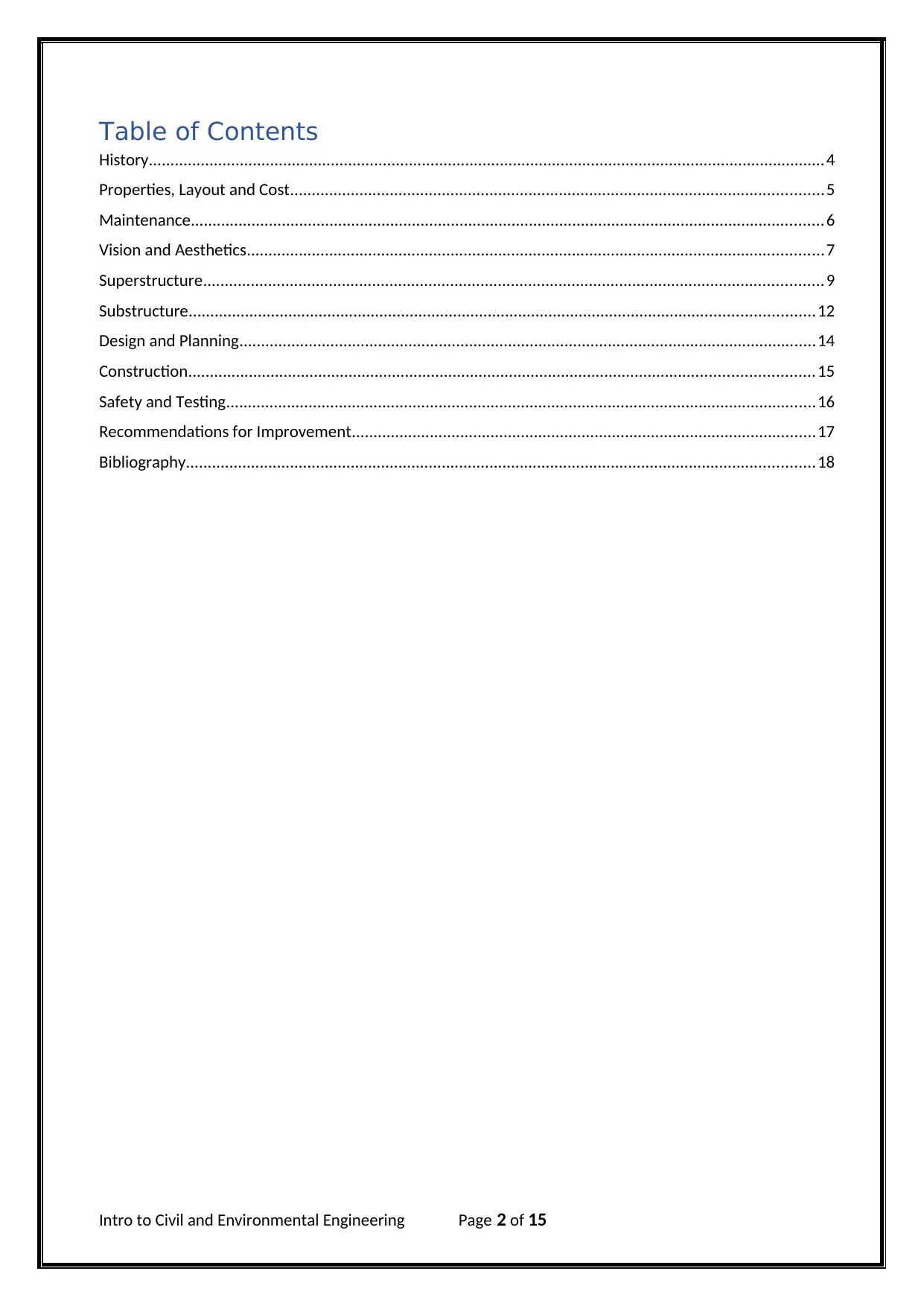
Table of Contents
History............................................................................................................................................................4
Properties, Layout and Cost...........................................................................................................................5
Maintenance..................................................................................................................................................6
Vision and Aesthetics.....................................................................................................................................7
Superstructure...............................................................................................................................................9
Substructure................................................................................................................................................12
Design and Planning.....................................................................................................................................14
Construction................................................................................................................................................15
Safety and Testing........................................................................................................................................16
Recommendations for Improvement...........................................................................................................17
Bibliography.................................................................................................................................................18
Intro to Civil and Environmental Engineering Page 2 of 15
History............................................................................................................................................................4
Properties, Layout and Cost...........................................................................................................................5
Maintenance..................................................................................................................................................6
Vision and Aesthetics.....................................................................................................................................7
Superstructure...............................................................................................................................................9
Substructure................................................................................................................................................12
Design and Planning.....................................................................................................................................14
Construction................................................................................................................................................15
Safety and Testing........................................................................................................................................16
Recommendations for Improvement...........................................................................................................17
Bibliography.................................................................................................................................................18
Intro to Civil and Environmental Engineering Page 2 of 15
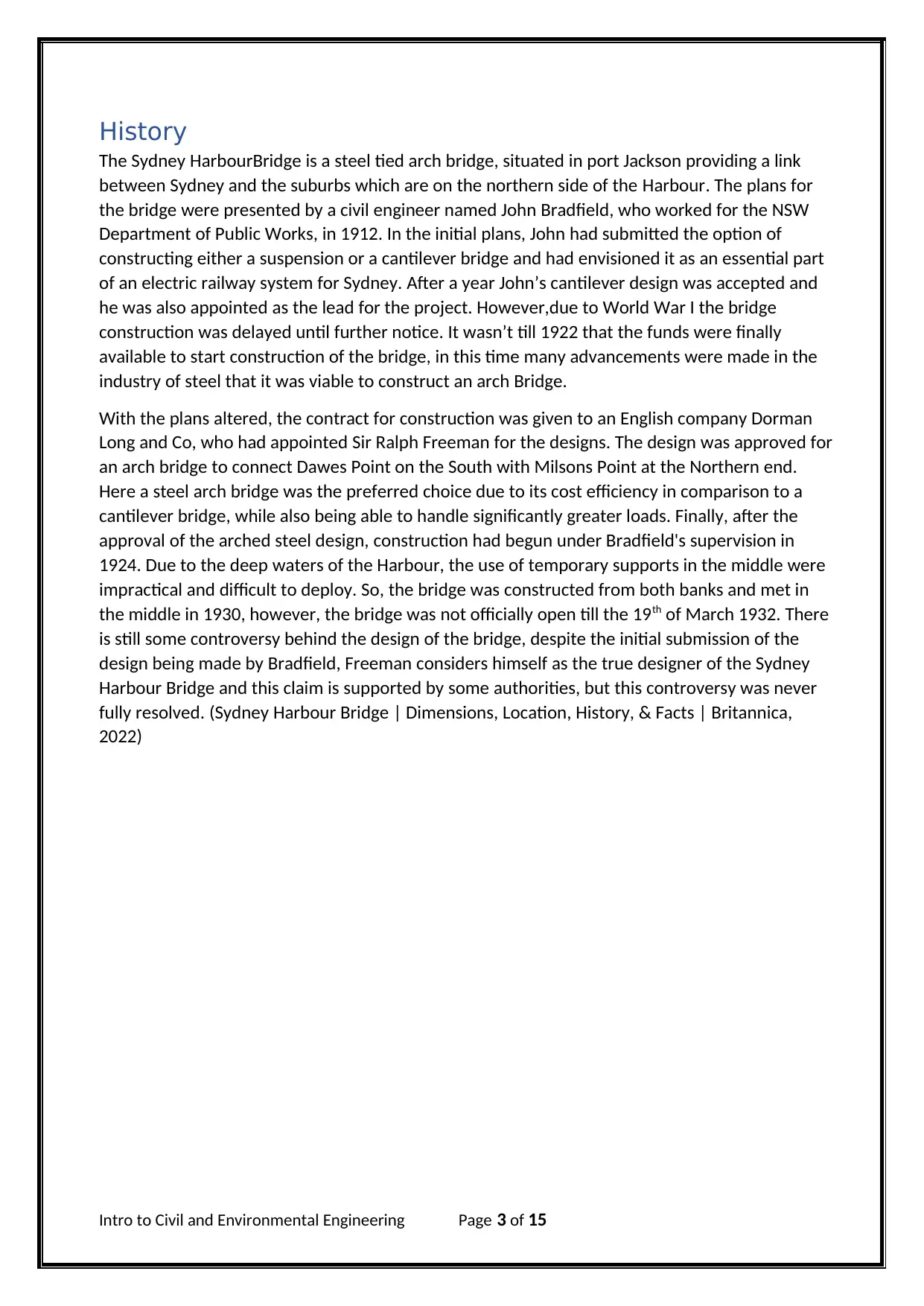
History
The Sydney HarbourBridge is a steel tied arch bridge, situated in port Jackson providing a link
between Sydney and the suburbs which are on the northern side of the Harbour. The plans for
the bridge were presented by a civil engineer named John Bradfield, who worked for the NSW
Department of Public Works, in 1912. In the initial plans, John had submitted the option of
constructing either a suspension or a cantilever bridge and had envisioned it as an essential part
of an electric railway system for Sydney. After a year John’s cantilever design was accepted and
he was also appointed as the lead for the project. However,due to World War I the bridge
construction was delayed until further notice. It wasn’t till 1922 that the funds were finally
available to start construction of the bridge, in this time many advancements were made in the
industry of steel that it was viable to construct an arch Bridge.
With the plans altered, the contract for construction was given to an English company Dorman
Long and Co, who had appointed Sir Ralph Freeman for the designs. The design was approved for
an arch bridge to connect Dawes Point on the South with Milsons Point at the Northern end.
Here a steel arch bridge was the preferred choice due to its cost efficiency in comparison to a
cantilever bridge, while also being able to handle significantly greater loads. Finally, after the
approval of the arched steel design, construction had begun under Bradfield's supervision in
1924. Due to the deep waters of the Harbour, the use of temporary supports in the middle were
impractical and difficult to deploy. So, the bridge was constructed from both banks and met in
the middle in 1930, however, the bridge was not officially open till the 19th of March 1932. There
is still some controversy behind the design of the bridge, despite the initial submission of the
design being made by Bradfield, Freeman considers himself as the true designer of the Sydney
Harbour Bridge and this claim is supported by some authorities, but this controversy was never
fully resolved. (Sydney Harbour Bridge | Dimensions, Location, History, & Facts | Britannica,
2022)
Intro to Civil and Environmental Engineering Page 3 of 15
The Sydney HarbourBridge is a steel tied arch bridge, situated in port Jackson providing a link
between Sydney and the suburbs which are on the northern side of the Harbour. The plans for
the bridge were presented by a civil engineer named John Bradfield, who worked for the NSW
Department of Public Works, in 1912. In the initial plans, John had submitted the option of
constructing either a suspension or a cantilever bridge and had envisioned it as an essential part
of an electric railway system for Sydney. After a year John’s cantilever design was accepted and
he was also appointed as the lead for the project. However,due to World War I the bridge
construction was delayed until further notice. It wasn’t till 1922 that the funds were finally
available to start construction of the bridge, in this time many advancements were made in the
industry of steel that it was viable to construct an arch Bridge.
With the plans altered, the contract for construction was given to an English company Dorman
Long and Co, who had appointed Sir Ralph Freeman for the designs. The design was approved for
an arch bridge to connect Dawes Point on the South with Milsons Point at the Northern end.
Here a steel arch bridge was the preferred choice due to its cost efficiency in comparison to a
cantilever bridge, while also being able to handle significantly greater loads. Finally, after the
approval of the arched steel design, construction had begun under Bradfield's supervision in
1924. Due to the deep waters of the Harbour, the use of temporary supports in the middle were
impractical and difficult to deploy. So, the bridge was constructed from both banks and met in
the middle in 1930, however, the bridge was not officially open till the 19th of March 1932. There
is still some controversy behind the design of the bridge, despite the initial submission of the
design being made by Bradfield, Freeman considers himself as the true designer of the Sydney
Harbour Bridge and this claim is supported by some authorities, but this controversy was never
fully resolved. (Sydney Harbour Bridge | Dimensions, Location, History, & Facts | Britannica,
2022)
Intro to Civil and Environmental Engineering Page 3 of 15
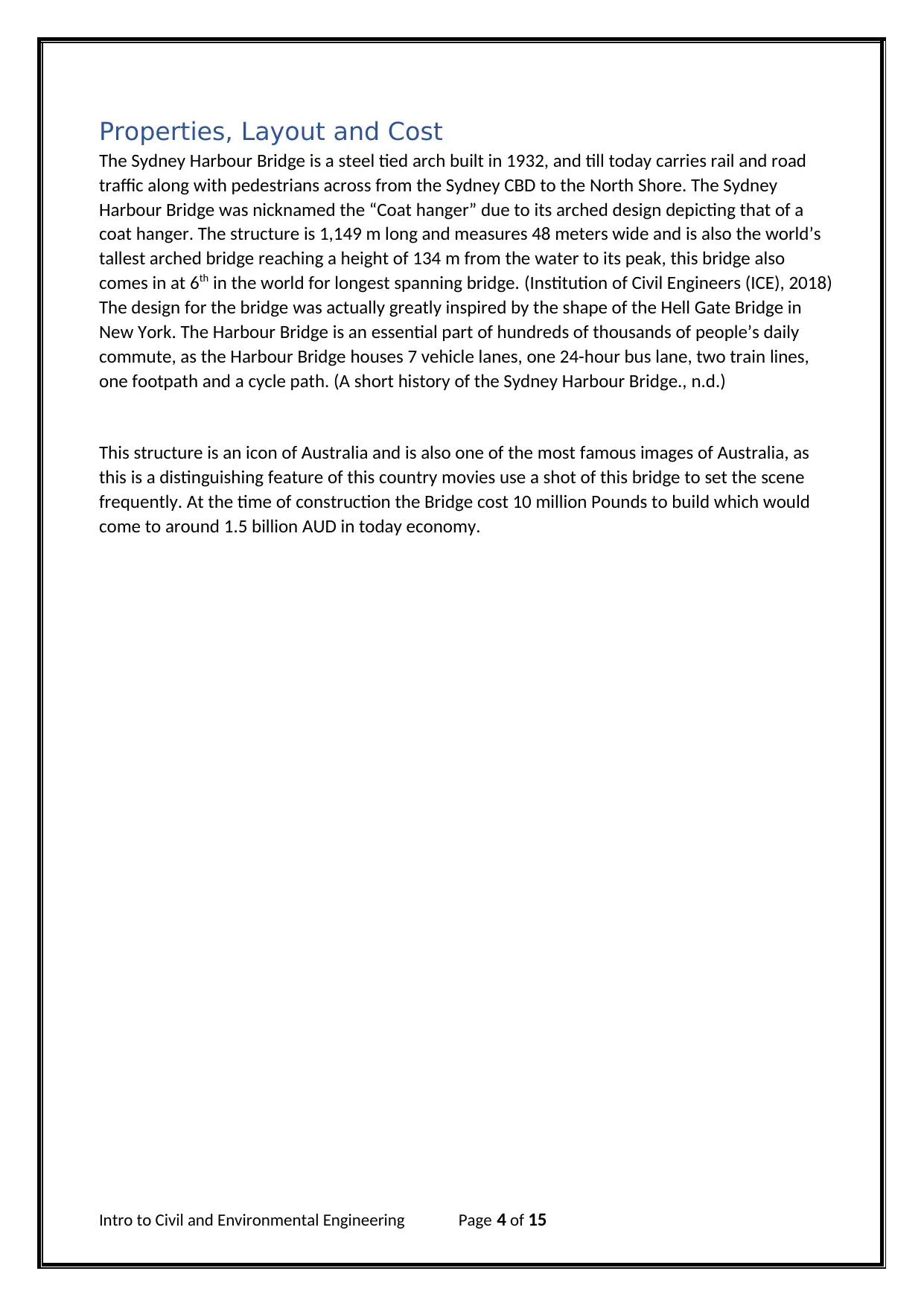
Properties, Layout and Cost
The Sydney Harbour Bridge is a steel tied arch built in 1932, and till today carries rail and road
traffic along with pedestrians across from the Sydney CBD to the North Shore. The Sydney
Harbour Bridge was nicknamed the “Coat hanger” due to its arched design depicting that of a
coat hanger. The structure is 1,149 m long and measures 48 meters wide and is also the world’s
tallest arched bridge reaching a height of 134 m from the water to its peak, this bridge also
comes in at 6th in the world for longest spanning bridge. (Institution of Civil Engineers (ICE), 2018)
The design for the bridge was actually greatly inspired by the shape of the Hell Gate Bridge in
New York. The Harbour Bridge is an essential part of hundreds of thousands of people’s daily
commute, as the Harbour Bridge houses 7 vehicle lanes, one 24-hour bus lane, two train lines,
one footpath and a cycle path. (A short history of the Sydney Harbour Bridge., n.d.)
This structure is an icon of Australia and is also one of the most famous images of Australia, as
this is a distinguishing feature of this country movies use a shot of this bridge to set the scene
frequently. At the time of construction the Bridge cost 10 million Pounds to build which would
come to around 1.5 billion AUD in today economy.
Intro to Civil and Environmental Engineering Page 4 of 15
The Sydney Harbour Bridge is a steel tied arch built in 1932, and till today carries rail and road
traffic along with pedestrians across from the Sydney CBD to the North Shore. The Sydney
Harbour Bridge was nicknamed the “Coat hanger” due to its arched design depicting that of a
coat hanger. The structure is 1,149 m long and measures 48 meters wide and is also the world’s
tallest arched bridge reaching a height of 134 m from the water to its peak, this bridge also
comes in at 6th in the world for longest spanning bridge. (Institution of Civil Engineers (ICE), 2018)
The design for the bridge was actually greatly inspired by the shape of the Hell Gate Bridge in
New York. The Harbour Bridge is an essential part of hundreds of thousands of people’s daily
commute, as the Harbour Bridge houses 7 vehicle lanes, one 24-hour bus lane, two train lines,
one footpath and a cycle path. (A short history of the Sydney Harbour Bridge., n.d.)
This structure is an icon of Australia and is also one of the most famous images of Australia, as
this is a distinguishing feature of this country movies use a shot of this bridge to set the scene
frequently. At the time of construction the Bridge cost 10 million Pounds to build which would
come to around 1.5 billion AUD in today economy.
Intro to Civil and Environmental Engineering Page 4 of 15
Secure Best Marks with AI Grader
Need help grading? Try our AI Grader for instant feedback on your assignments.
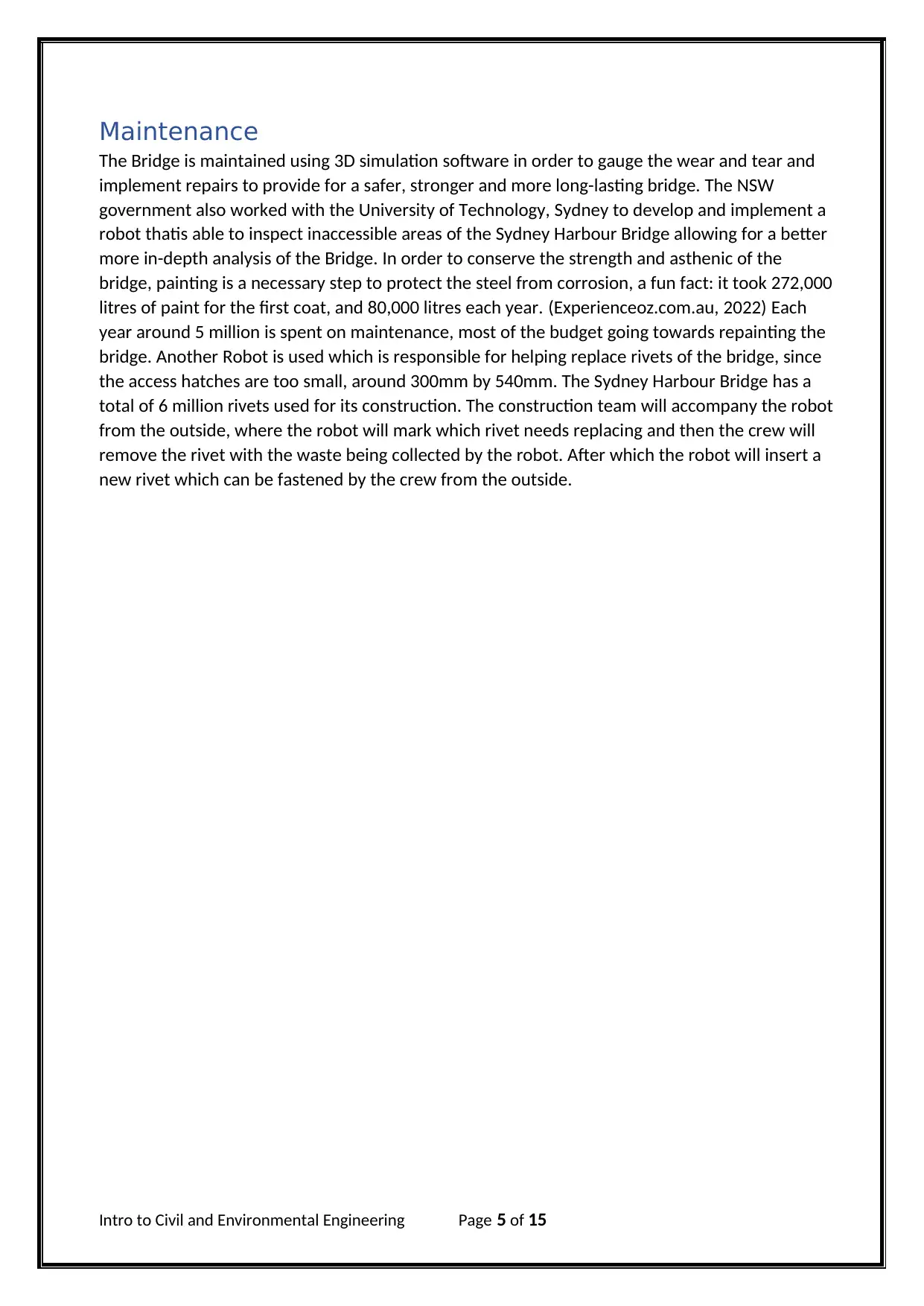
Maintenance
The Bridge is maintained using 3D simulation software in order to gauge the wear and tear and
implement repairs to provide for a safer, stronger and more long-lasting bridge. The NSW
government also worked with the University of Technology, Sydney to develop and implement a
robot thatis able to inspect inaccessible areas of the Sydney Harbour Bridge allowing for a better
more in-depth analysis of the Bridge. In order to conserve the strength and asthenic of the
bridge, painting is a necessary step to protect the steel from corrosion, a fun fact: it took 272,000
litres of paint for the first coat, and 80,000 litres each year. (Experienceoz.com.au, 2022) Each
year around 5 million is spent on maintenance, most of the budget going towards repainting the
bridge. Another Robot is used which is responsible for helping replace rivets of the bridge, since
the access hatches are too small, around 300mm by 540mm. The Sydney Harbour Bridge has a
total of 6 million rivets used for its construction. The construction team will accompany the robot
from the outside, where the robot will mark which rivet needs replacing and then the crew will
remove the rivet with the waste being collected by the robot. After which the robot will insert a
new rivet which can be fastened by the crew from the outside.
Intro to Civil and Environmental Engineering Page 5 of 15
The Bridge is maintained using 3D simulation software in order to gauge the wear and tear and
implement repairs to provide for a safer, stronger and more long-lasting bridge. The NSW
government also worked with the University of Technology, Sydney to develop and implement a
robot thatis able to inspect inaccessible areas of the Sydney Harbour Bridge allowing for a better
more in-depth analysis of the Bridge. In order to conserve the strength and asthenic of the
bridge, painting is a necessary step to protect the steel from corrosion, a fun fact: it took 272,000
litres of paint for the first coat, and 80,000 litres each year. (Experienceoz.com.au, 2022) Each
year around 5 million is spent on maintenance, most of the budget going towards repainting the
bridge. Another Robot is used which is responsible for helping replace rivets of the bridge, since
the access hatches are too small, around 300mm by 540mm. The Sydney Harbour Bridge has a
total of 6 million rivets used for its construction. The construction team will accompany the robot
from the outside, where the robot will mark which rivet needs replacing and then the crew will
remove the rivet with the waste being collected by the robot. After which the robot will insert a
new rivet which can be fastened by the crew from the outside.
Intro to Civil and Environmental Engineering Page 5 of 15
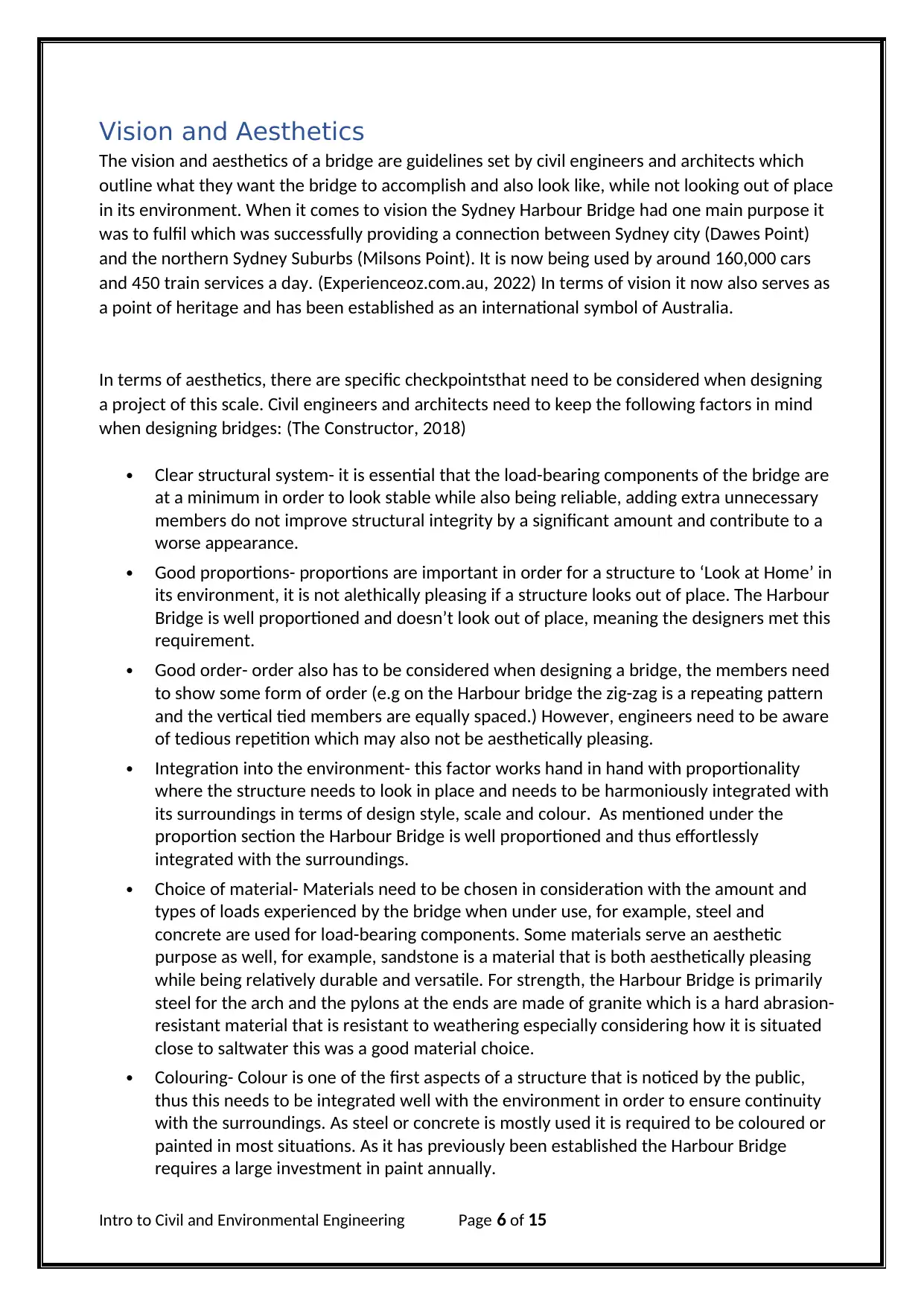
Vision and Aesthetics
The vision and aesthetics of a bridge are guidelines set by civil engineers and architects which
outline what they want the bridge to accomplish and also look like, while not looking out of place
in its environment. When it comes to vision the Sydney Harbour Bridge had one main purpose it
was to fulfil which was successfully providing a connection between Sydney city (Dawes Point)
and the northern Sydney Suburbs (Milsons Point). It is now being used by around 160,000 cars
and 450 train services a day. (Experienceoz.com.au, 2022) In terms of vision it now also serves as
a point of heritage and has been established as an international symbol of Australia.
In terms of aesthetics, there are specific checkpointsthat need to be considered when designing
a project of this scale. Civil engineers and architects need to keep the following factors in mind
when designing bridges: (The Constructor, 2018)
Clear structural system- it is essential that the load-bearing components of the bridge are
at a minimum in order to look stable while also being reliable, adding extra unnecessary
members do not improve structural integrity by a significant amount and contribute to a
worse appearance.
Good proportions- proportions are important in order for a structure to ‘Look at Home’ in
its environment, it is not alethically pleasing if a structure looks out of place. The Harbour
Bridge is well proportioned and doesn’t look out of place, meaning the designers met this
requirement.
Good order- order also has to be considered when designing a bridge, the members need
to show some form of order (e.g on the Harbour bridge the zig-zag is a repeating pattern
and the vertical tied members are equally spaced.) However, engineers need to be aware
of tedious repetition which may also not be aesthetically pleasing.
Integration into the environment- this factor works hand in hand with proportionality
where the structure needs to look in place and needs to be harmoniously integrated with
its surroundings in terms of design style, scale and colour. As mentioned under the
proportion section the Harbour Bridge is well proportioned and thus effortlessly
integrated with the surroundings.
Choice of material- Materials need to be chosen in consideration with the amount and
types of loads experienced by the bridge when under use, for example, steel and
concrete are used for load-bearing components. Some materials serve an aesthetic
purpose as well, for example, sandstone is a material that is both aesthetically pleasing
while being relatively durable and versatile. For strength, the Harbour Bridge is primarily
steel for the arch and the pylons at the ends are made of granite which is a hard abrasion-
resistant material that is resistant to weathering especially considering how it is situated
close to saltwater this was a good material choice.
Colouring- Colour is one of the first aspects of a structure that is noticed by the public,
thus this needs to be integrated well with the environment in order to ensure continuity
with the surroundings. As steel or concrete is mostly used it is required to be coloured or
painted in most situations. As it has previously been established the Harbour Bridge
requires a large investment in paint annually.
Intro to Civil and Environmental Engineering Page 6 of 15
The vision and aesthetics of a bridge are guidelines set by civil engineers and architects which
outline what they want the bridge to accomplish and also look like, while not looking out of place
in its environment. When it comes to vision the Sydney Harbour Bridge had one main purpose it
was to fulfil which was successfully providing a connection between Sydney city (Dawes Point)
and the northern Sydney Suburbs (Milsons Point). It is now being used by around 160,000 cars
and 450 train services a day. (Experienceoz.com.au, 2022) In terms of vision it now also serves as
a point of heritage and has been established as an international symbol of Australia.
In terms of aesthetics, there are specific checkpointsthat need to be considered when designing
a project of this scale. Civil engineers and architects need to keep the following factors in mind
when designing bridges: (The Constructor, 2018)
Clear structural system- it is essential that the load-bearing components of the bridge are
at a minimum in order to look stable while also being reliable, adding extra unnecessary
members do not improve structural integrity by a significant amount and contribute to a
worse appearance.
Good proportions- proportions are important in order for a structure to ‘Look at Home’ in
its environment, it is not alethically pleasing if a structure looks out of place. The Harbour
Bridge is well proportioned and doesn’t look out of place, meaning the designers met this
requirement.
Good order- order also has to be considered when designing a bridge, the members need
to show some form of order (e.g on the Harbour bridge the zig-zag is a repeating pattern
and the vertical tied members are equally spaced.) However, engineers need to be aware
of tedious repetition which may also not be aesthetically pleasing.
Integration into the environment- this factor works hand in hand with proportionality
where the structure needs to look in place and needs to be harmoniously integrated with
its surroundings in terms of design style, scale and colour. As mentioned under the
proportion section the Harbour Bridge is well proportioned and thus effortlessly
integrated with the surroundings.
Choice of material- Materials need to be chosen in consideration with the amount and
types of loads experienced by the bridge when under use, for example, steel and
concrete are used for load-bearing components. Some materials serve an aesthetic
purpose as well, for example, sandstone is a material that is both aesthetically pleasing
while being relatively durable and versatile. For strength, the Harbour Bridge is primarily
steel for the arch and the pylons at the ends are made of granite which is a hard abrasion-
resistant material that is resistant to weathering especially considering how it is situated
close to saltwater this was a good material choice.
Colouring- Colour is one of the first aspects of a structure that is noticed by the public,
thus this needs to be integrated well with the environment in order to ensure continuity
with the surroundings. As steel or concrete is mostly used it is required to be coloured or
painted in most situations. As it has previously been established the Harbour Bridge
requires a large investment in paint annually.
Intro to Civil and Environmental Engineering Page 6 of 15
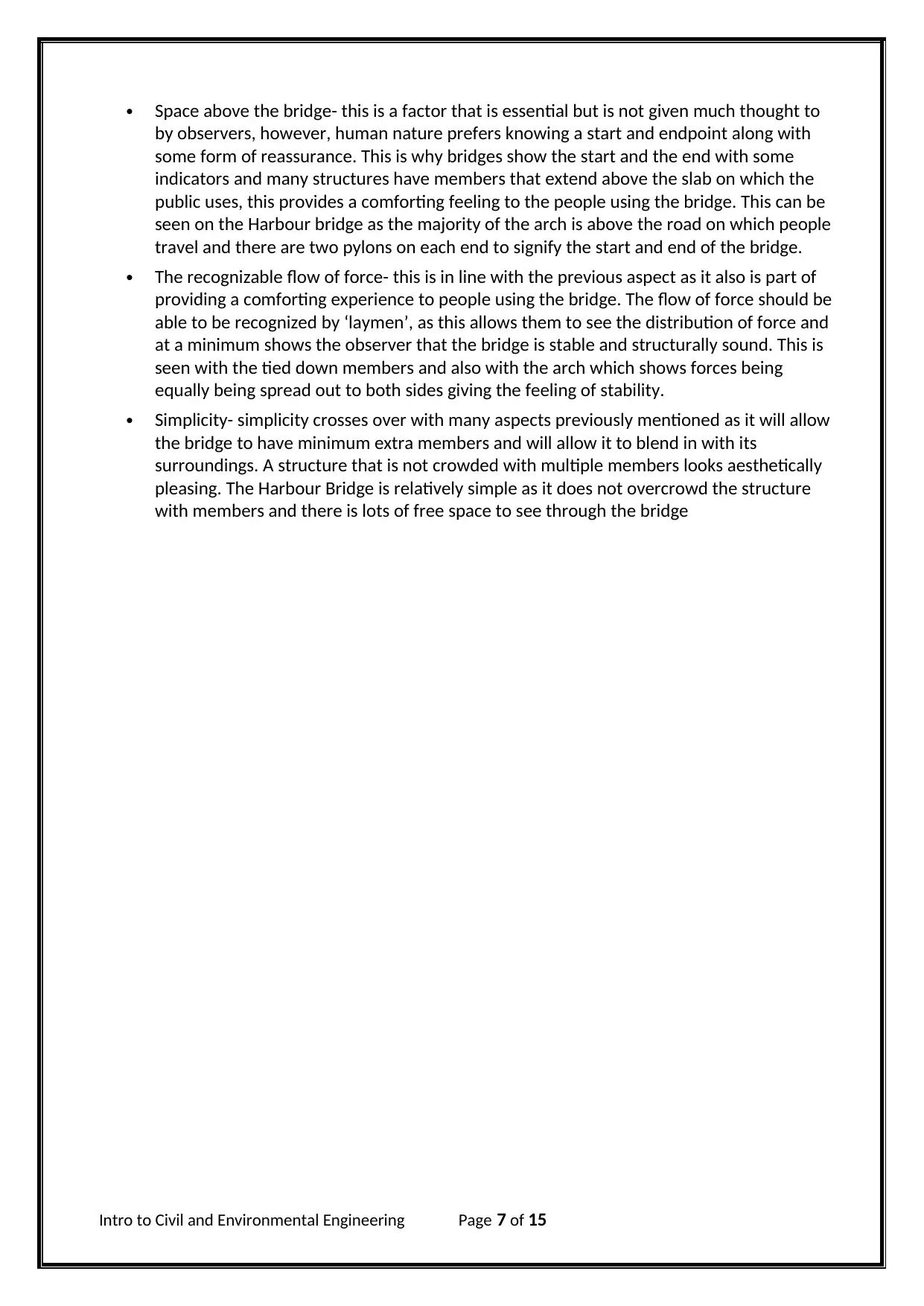
Space above the bridge- this is a factor that is essential but is not given much thought to
by observers, however, human nature prefers knowing a start and endpoint along with
some form of reassurance. This is why bridges show the start and the end with some
indicators and many structures have members that extend above the slab on which the
public uses, this provides a comforting feeling to the people using the bridge. This can be
seen on the Harbour bridge as the majority of the arch is above the road on which people
travel and there are two pylons on each end to signify the start and end of the bridge.
The recognizable flow of force- this is in line with the previous aspect as it also is part of
providing a comforting experience to people using the bridge. The flow of force should be
able to be recognized by ‘laymen’, as this allows them to see the distribution of force and
at a minimum shows the observer that the bridge is stable and structurally sound. This is
seen with the tied down members and also with the arch which shows forces being
equally being spread out to both sides giving the feeling of stability.
Simplicity- simplicity crosses over with many aspects previously mentioned as it will allow
the bridge to have minimum extra members and will allow it to blend in with its
surroundings. A structure that is not crowded with multiple members looks aesthetically
pleasing. The Harbour Bridge is relatively simple as it does not overcrowd the structure
with members and there is lots of free space to see through the bridge
Intro to Civil and Environmental Engineering Page 7 of 15
by observers, however, human nature prefers knowing a start and endpoint along with
some form of reassurance. This is why bridges show the start and the end with some
indicators and many structures have members that extend above the slab on which the
public uses, this provides a comforting feeling to the people using the bridge. This can be
seen on the Harbour bridge as the majority of the arch is above the road on which people
travel and there are two pylons on each end to signify the start and end of the bridge.
The recognizable flow of force- this is in line with the previous aspect as it also is part of
providing a comforting experience to people using the bridge. The flow of force should be
able to be recognized by ‘laymen’, as this allows them to see the distribution of force and
at a minimum shows the observer that the bridge is stable and structurally sound. This is
seen with the tied down members and also with the arch which shows forces being
equally being spread out to both sides giving the feeling of stability.
Simplicity- simplicity crosses over with many aspects previously mentioned as it will allow
the bridge to have minimum extra members and will allow it to blend in with its
surroundings. A structure that is not crowded with multiple members looks aesthetically
pleasing. The Harbour Bridge is relatively simple as it does not overcrowd the structure
with members and there is lots of free space to see through the bridge
Intro to Civil and Environmental Engineering Page 7 of 15
Paraphrase This Document
Need a fresh take? Get an instant paraphrase of this document with our AI Paraphraser
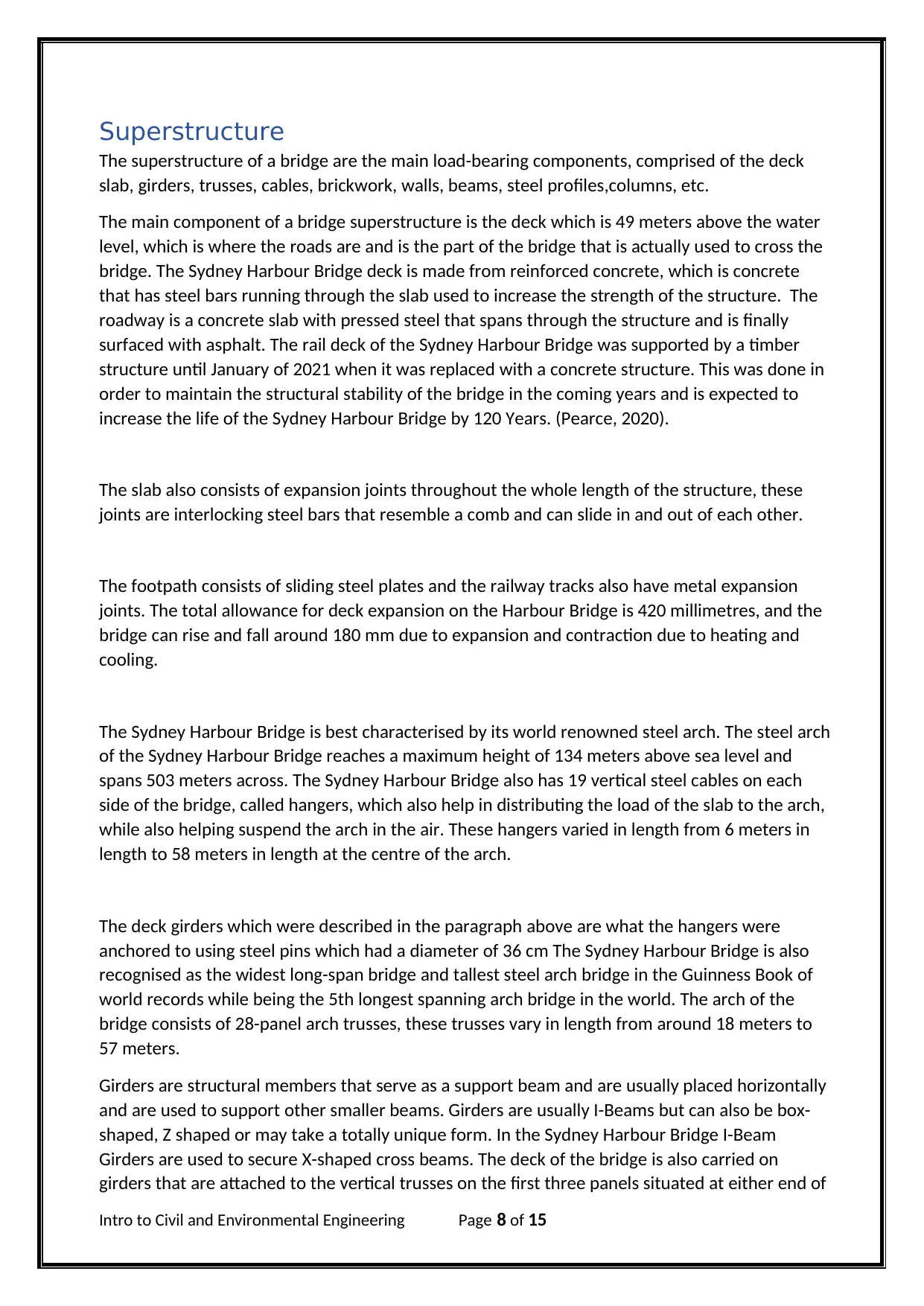
Superstructure
The superstructure of a bridge are the main load-bearing components, comprised of the deck
slab, girders, trusses, cables, brickwork, walls, beams, steel profiles,columns, etc.
The main component of a bridge superstructure is the deck which is 49 meters above the water
level, which is where the roads are and is the part of the bridge that is actually used to cross the
bridge. The Sydney Harbour Bridge deck is made from reinforced concrete, which is concrete
that has steel bars running through the slab used to increase the strength of the structure. The
roadway is a concrete slab with pressed steel that spans through the structure and is finally
surfaced with asphalt. The rail deck of the Sydney Harbour Bridge was supported by a timber
structure until January of 2021 when it was replaced with a concrete structure. This was done in
order to maintain the structural stability of the bridge in the coming years and is expected to
increase the life of the Sydney Harbour Bridge by 120 Years. (Pearce, 2020).
The slab also consists of expansion joints throughout the whole length of the structure, these
joints are interlocking steel bars that resemble a comb and can slide in and out of each other.
The footpath consists of sliding steel plates and the railway tracks also have metal expansion
joints. The total allowance for deck expansion on the Harbour Bridge is 420 millimetres, and the
bridge can rise and fall around 180 mm due to expansion and contraction due to heating and
cooling.
The Sydney Harbour Bridge is best characterised by its world renowned steel arch. The steel arch
of the Sydney Harbour Bridge reaches a maximum height of 134 meters above sea level and
spans 503 meters across. The Sydney Harbour Bridge also has 19 vertical steel cables on each
side of the bridge, called hangers, which also help in distributing the load of the slab to the arch,
while also helping suspend the arch in the air. These hangers varied in length from 6 meters in
length to 58 meters in length at the centre of the arch.
The deck girders which were described in the paragraph above are what the hangers were
anchored to using steel pins which had a diameter of 36 cm The Sydney Harbour Bridge is also
recognised as the widest long-span bridge and tallest steel arch bridge in the Guinness Book of
world records while being the 5th longest spanning arch bridge in the world. The arch of the
bridge consists of 28-panel arch trusses, these trusses vary in length from around 18 meters to
57 meters.
Girders are structural members that serve as a support beam and are usually placed horizontally
and are used to support other smaller beams. Girders are usually I-Beams but can also be box-
shaped, Z shaped or may take a totally unique form. In the Sydney Harbour Bridge I-Beam
Girders are used to secure X-shaped cross beams. The deck of the bridge is also carried on
girders that are attached to the vertical trusses on the first three panels situated at either end of
Intro to Civil and Environmental Engineering Page 8 of 15
The superstructure of a bridge are the main load-bearing components, comprised of the deck
slab, girders, trusses, cables, brickwork, walls, beams, steel profiles,columns, etc.
The main component of a bridge superstructure is the deck which is 49 meters above the water
level, which is where the roads are and is the part of the bridge that is actually used to cross the
bridge. The Sydney Harbour Bridge deck is made from reinforced concrete, which is concrete
that has steel bars running through the slab used to increase the strength of the structure. The
roadway is a concrete slab with pressed steel that spans through the structure and is finally
surfaced with asphalt. The rail deck of the Sydney Harbour Bridge was supported by a timber
structure until January of 2021 when it was replaced with a concrete structure. This was done in
order to maintain the structural stability of the bridge in the coming years and is expected to
increase the life of the Sydney Harbour Bridge by 120 Years. (Pearce, 2020).
The slab also consists of expansion joints throughout the whole length of the structure, these
joints are interlocking steel bars that resemble a comb and can slide in and out of each other.
The footpath consists of sliding steel plates and the railway tracks also have metal expansion
joints. The total allowance for deck expansion on the Harbour Bridge is 420 millimetres, and the
bridge can rise and fall around 180 mm due to expansion and contraction due to heating and
cooling.
The Sydney Harbour Bridge is best characterised by its world renowned steel arch. The steel arch
of the Sydney Harbour Bridge reaches a maximum height of 134 meters above sea level and
spans 503 meters across. The Sydney Harbour Bridge also has 19 vertical steel cables on each
side of the bridge, called hangers, which also help in distributing the load of the slab to the arch,
while also helping suspend the arch in the air. These hangers varied in length from 6 meters in
length to 58 meters in length at the centre of the arch.
The deck girders which were described in the paragraph above are what the hangers were
anchored to using steel pins which had a diameter of 36 cm The Sydney Harbour Bridge is also
recognised as the widest long-span bridge and tallest steel arch bridge in the Guinness Book of
world records while being the 5th longest spanning arch bridge in the world. The arch of the
bridge consists of 28-panel arch trusses, these trusses vary in length from around 18 meters to
57 meters.
Girders are structural members that serve as a support beam and are usually placed horizontally
and are used to support other smaller beams. Girders are usually I-Beams but can also be box-
shaped, Z shaped or may take a totally unique form. In the Sydney Harbour Bridge I-Beam
Girders are used to secure X-shaped cross beams. The deck of the bridge is also carried on
girders that are attached to the vertical trusses on the first three panels situated at either end of
Intro to Civil and Environmental Engineering Page 8 of 15
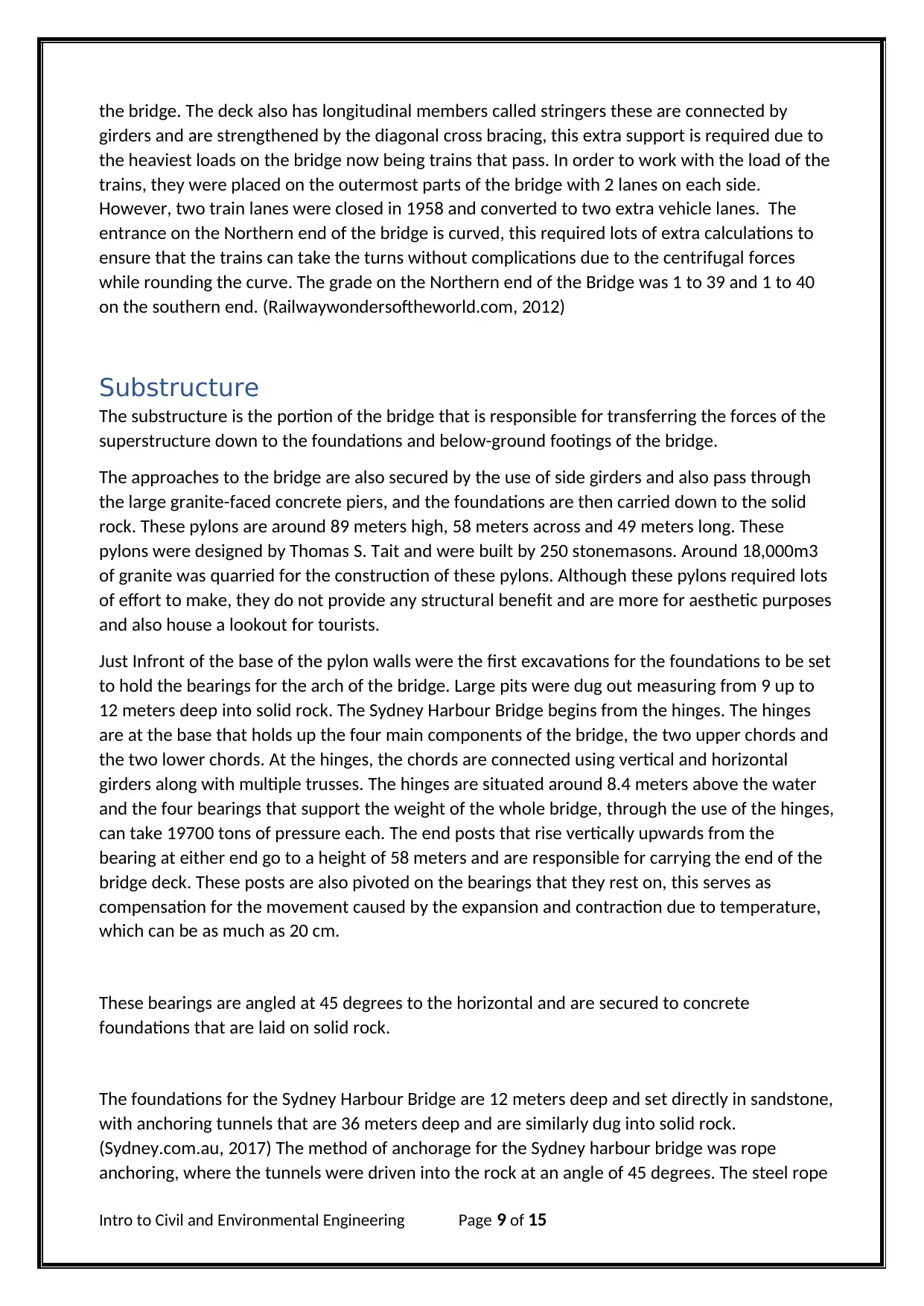
the bridge. The deck also has longitudinal members called stringers these are connected by
girders and are strengthened by the diagonal cross bracing, this extra support is required due to
the heaviest loads on the bridge now being trains that pass. In order to work with the load of the
trains, they were placed on the outermost parts of the bridge with 2 lanes on each side.
However, two train lanes were closed in 1958 and converted to two extra vehicle lanes. The
entrance on the Northern end of the bridge is curved, this required lots of extra calculations to
ensure that the trains can take the turns without complications due to the centrifugal forces
while rounding the curve. The grade on the Northern end of the Bridge was 1 to 39 and 1 to 40
on the southern end. (Railwaywondersoftheworld.com, 2012)
Substructure
The substructure is the portion of the bridge that is responsible for transferring the forces of the
superstructure down to the foundations and below-ground footings of the bridge.
The approaches to the bridge are also secured by the use of side girders and also pass through
the large granite-faced concrete piers, and the foundations are then carried down to the solid
rock. These pylons are around 89 meters high, 58 meters across and 49 meters long. These
pylons were designed by Thomas S. Tait and were built by 250 stonemasons. Around 18,000m3
of granite was quarried for the construction of these pylons. Although these pylons required lots
of effort to make, they do not provide any structural benefit and are more for aesthetic purposes
and also house a lookout for tourists.
Just Infront of the base of the pylon walls were the first excavations for the foundations to be set
to hold the bearings for the arch of the bridge. Large pits were dug out measuring from 9 up to
12 meters deep into solid rock. The Sydney Harbour Bridge begins from the hinges. The hinges
are at the base that holds up the four main components of the bridge, the two upper chords and
the two lower chords. At the hinges, the chords are connected using vertical and horizontal
girders along with multiple trusses. The hinges are situated around 8.4 meters above the water
and the four bearings that support the weight of the whole bridge, through the use of the hinges,
can take 19700 tons of pressure each. The end posts that rise vertically upwards from the
bearing at either end go to a height of 58 meters and are responsible for carrying the end of the
bridge deck. These posts are also pivoted on the bearings that they rest on, this serves as
compensation for the movement caused by the expansion and contraction due to temperature,
which can be as much as 20 cm.
These bearings are angled at 45 degrees to the horizontal and are secured to concrete
foundations that are laid on solid rock.
The foundations for the Sydney Harbour Bridge are 12 meters deep and set directly in sandstone,
with anchoring tunnels that are 36 meters deep and are similarly dug into solid rock.
(Sydney.com.au, 2017) The method of anchorage for the Sydney harbour bridge was rope
anchoring, where the tunnels were driven into the rock at an angle of 45 degrees. The steel rope
Intro to Civil and Environmental Engineering Page 9 of 15
girders and are strengthened by the diagonal cross bracing, this extra support is required due to
the heaviest loads on the bridge now being trains that pass. In order to work with the load of the
trains, they were placed on the outermost parts of the bridge with 2 lanes on each side.
However, two train lanes were closed in 1958 and converted to two extra vehicle lanes. The
entrance on the Northern end of the bridge is curved, this required lots of extra calculations to
ensure that the trains can take the turns without complications due to the centrifugal forces
while rounding the curve. The grade on the Northern end of the Bridge was 1 to 39 and 1 to 40
on the southern end. (Railwaywondersoftheworld.com, 2012)
Substructure
The substructure is the portion of the bridge that is responsible for transferring the forces of the
superstructure down to the foundations and below-ground footings of the bridge.
The approaches to the bridge are also secured by the use of side girders and also pass through
the large granite-faced concrete piers, and the foundations are then carried down to the solid
rock. These pylons are around 89 meters high, 58 meters across and 49 meters long. These
pylons were designed by Thomas S. Tait and were built by 250 stonemasons. Around 18,000m3
of granite was quarried for the construction of these pylons. Although these pylons required lots
of effort to make, they do not provide any structural benefit and are more for aesthetic purposes
and also house a lookout for tourists.
Just Infront of the base of the pylon walls were the first excavations for the foundations to be set
to hold the bearings for the arch of the bridge. Large pits were dug out measuring from 9 up to
12 meters deep into solid rock. The Sydney Harbour Bridge begins from the hinges. The hinges
are at the base that holds up the four main components of the bridge, the two upper chords and
the two lower chords. At the hinges, the chords are connected using vertical and horizontal
girders along with multiple trusses. The hinges are situated around 8.4 meters above the water
and the four bearings that support the weight of the whole bridge, through the use of the hinges,
can take 19700 tons of pressure each. The end posts that rise vertically upwards from the
bearing at either end go to a height of 58 meters and are responsible for carrying the end of the
bridge deck. These posts are also pivoted on the bearings that they rest on, this serves as
compensation for the movement caused by the expansion and contraction due to temperature,
which can be as much as 20 cm.
These bearings are angled at 45 degrees to the horizontal and are secured to concrete
foundations that are laid on solid rock.
The foundations for the Sydney Harbour Bridge are 12 meters deep and set directly in sandstone,
with anchoring tunnels that are 36 meters deep and are similarly dug into solid rock.
(Sydney.com.au, 2017) The method of anchorage for the Sydney harbour bridge was rope
anchoring, where the tunnels were driven into the rock at an angle of 45 degrees. The steel rope
Intro to Civil and Environmental Engineering Page 9 of 15
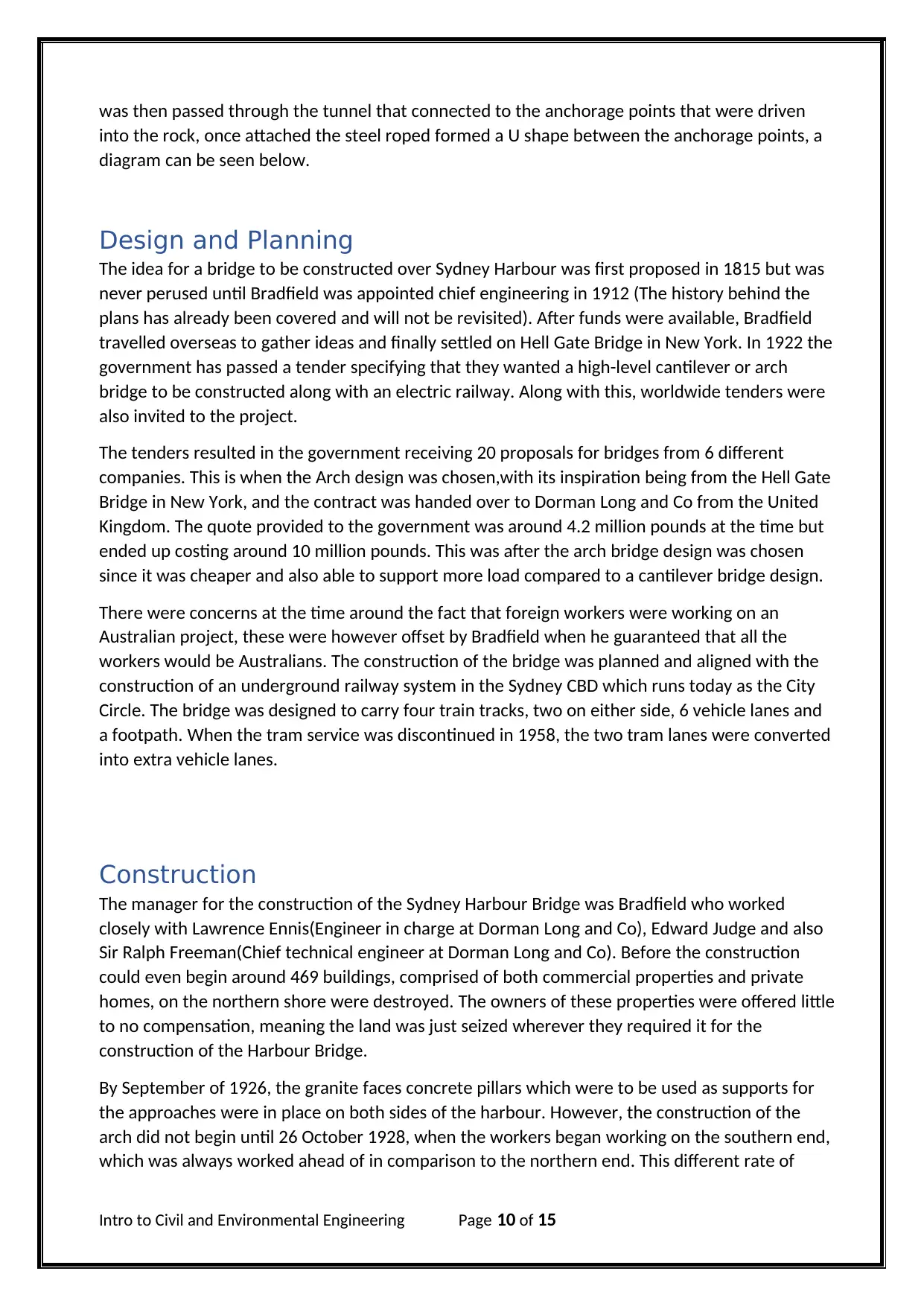
was then passed through the tunnel that connected to the anchorage points that were driven
into the rock, once attached the steel roped formed a U shape between the anchorage points, a
diagram can be seen below.
Design and Planning
The idea for a bridge to be constructed over Sydney Harbour was first proposed in 1815 but was
never perused until Bradfield was appointed chief engineering in 1912 (The history behind the
plans has already been covered and will not be revisited). After funds were available, Bradfield
travelled overseas to gather ideas and finally settled on Hell Gate Bridge in New York. In 1922 the
government has passed a tender specifying that they wanted a high-level cantilever or arch
bridge to be constructed along with an electric railway. Along with this, worldwide tenders were
also invited to the project.
The tenders resulted in the government receiving 20 proposals for bridges from 6 different
companies. This is when the Arch design was chosen,with its inspiration being from the Hell Gate
Bridge in New York, and the contract was handed over to Dorman Long and Co from the United
Kingdom. The quote provided to the government was around 4.2 million pounds at the time but
ended up costing around 10 million pounds. This was after the arch bridge design was chosen
since it was cheaper and also able to support more load compared to a cantilever bridge design.
There were concerns at the time around the fact that foreign workers were working on an
Australian project, these were however offset by Bradfield when he guaranteed that all the
workers would be Australians. The construction of the bridge was planned and aligned with the
construction of an underground railway system in the Sydney CBD which runs today as the City
Circle. The bridge was designed to carry four train tracks, two on either side, 6 vehicle lanes and
a footpath. When the tram service was discontinued in 1958, the two tram lanes were converted
into extra vehicle lanes.
Construction
The manager for the construction of the Sydney Harbour Bridge was Bradfield who worked
closely with Lawrence Ennis(Engineer in charge at Dorman Long and Co), Edward Judge and also
Sir Ralph Freeman(Chief technical engineer at Dorman Long and Co). Before the construction
could even begin around 469 buildings, comprised of both commercial properties and private
homes, on the northern shore were destroyed. The owners of these properties were offered little
to no compensation, meaning the land was just seized wherever they required it for the
construction of the Harbour Bridge.
By September of 1926, the granite faces concrete pillars which were to be used as supports for
the approaches were in place on both sides of the harbour. However, the construction of the
arch did not begin until 26 October 1928, when the workers began working on the southern end,
which was always worked ahead of in comparison to the northern end. This different rate of
Intro to Civil and Environmental Engineering Page 10 of 15
into the rock, once attached the steel roped formed a U shape between the anchorage points, a
diagram can be seen below.
Design and Planning
The idea for a bridge to be constructed over Sydney Harbour was first proposed in 1815 but was
never perused until Bradfield was appointed chief engineering in 1912 (The history behind the
plans has already been covered and will not be revisited). After funds were available, Bradfield
travelled overseas to gather ideas and finally settled on Hell Gate Bridge in New York. In 1922 the
government has passed a tender specifying that they wanted a high-level cantilever or arch
bridge to be constructed along with an electric railway. Along with this, worldwide tenders were
also invited to the project.
The tenders resulted in the government receiving 20 proposals for bridges from 6 different
companies. This is when the Arch design was chosen,with its inspiration being from the Hell Gate
Bridge in New York, and the contract was handed over to Dorman Long and Co from the United
Kingdom. The quote provided to the government was around 4.2 million pounds at the time but
ended up costing around 10 million pounds. This was after the arch bridge design was chosen
since it was cheaper and also able to support more load compared to a cantilever bridge design.
There were concerns at the time around the fact that foreign workers were working on an
Australian project, these were however offset by Bradfield when he guaranteed that all the
workers would be Australians. The construction of the bridge was planned and aligned with the
construction of an underground railway system in the Sydney CBD which runs today as the City
Circle. The bridge was designed to carry four train tracks, two on either side, 6 vehicle lanes and
a footpath. When the tram service was discontinued in 1958, the two tram lanes were converted
into extra vehicle lanes.
Construction
The manager for the construction of the Sydney Harbour Bridge was Bradfield who worked
closely with Lawrence Ennis(Engineer in charge at Dorman Long and Co), Edward Judge and also
Sir Ralph Freeman(Chief technical engineer at Dorman Long and Co). Before the construction
could even begin around 469 buildings, comprised of both commercial properties and private
homes, on the northern shore were destroyed. The owners of these properties were offered little
to no compensation, meaning the land was just seized wherever they required it for the
construction of the Harbour Bridge.
By September of 1926, the granite faces concrete pillars which were to be used as supports for
the approaches were in place on both sides of the harbour. However, the construction of the
arch did not begin until 26 October 1928, when the workers began working on the southern end,
which was always worked ahead of in comparison to the northern end. This different rate of
Intro to Civil and Environmental Engineering Page 10 of 15
Secure Best Marks with AI Grader
Need help grading? Try our AI Grader for instant feedback on your assignments.
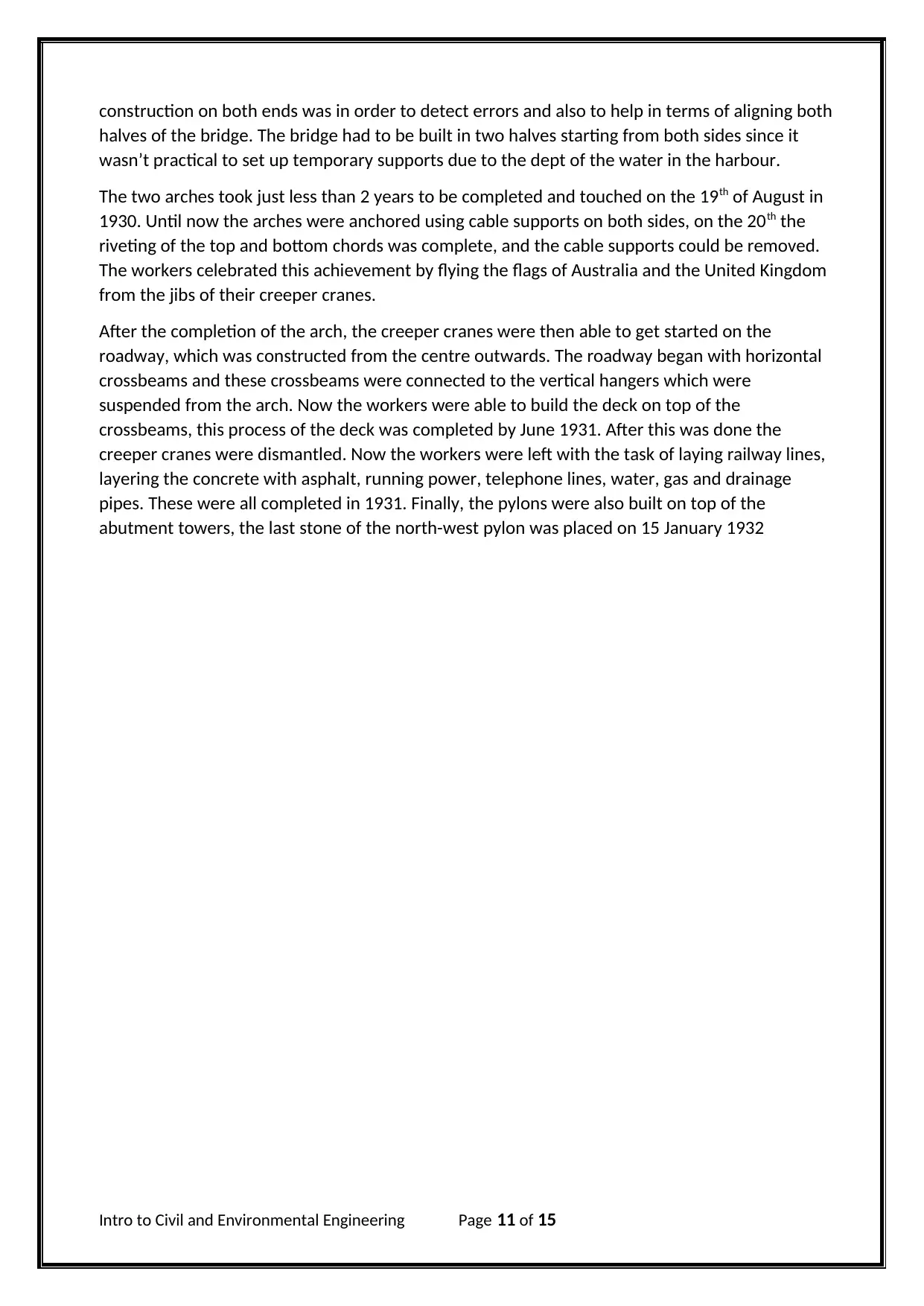
construction on both ends was in order to detect errors and also to help in terms of aligning both
halves of the bridge. The bridge had to be built in two halves starting from both sides since it
wasn’t practical to set up temporary supports due to the dept of the water in the harbour.
The two arches took just less than 2 years to be completed and touched on the 19th of August in
1930. Until now the arches were anchored using cable supports on both sides, on the 20th the
riveting of the top and bottom chords was complete, and the cable supports could be removed.
The workers celebrated this achievement by flying the flags of Australia and the United Kingdom
from the jibs of their creeper cranes.
After the completion of the arch, the creeper cranes were then able to get started on the
roadway, which was constructed from the centre outwards. The roadway began with horizontal
crossbeams and these crossbeams were connected to the vertical hangers which were
suspended from the arch. Now the workers were able to build the deck on top of the
crossbeams, this process of the deck was completed by June 1931. After this was done the
creeper cranes were dismantled. Now the workers were left with the task of laying railway lines,
layering the concrete with asphalt, running power, telephone lines, water, gas and drainage
pipes. These were all completed in 1931. Finally, the pylons were also built on top of the
abutment towers, the last stone of the north-west pylon was placed on 15 January 1932
Intro to Civil and Environmental Engineering Page 11 of 15
halves of the bridge. The bridge had to be built in two halves starting from both sides since it
wasn’t practical to set up temporary supports due to the dept of the water in the harbour.
The two arches took just less than 2 years to be completed and touched on the 19th of August in
1930. Until now the arches were anchored using cable supports on both sides, on the 20th the
riveting of the top and bottom chords was complete, and the cable supports could be removed.
The workers celebrated this achievement by flying the flags of Australia and the United Kingdom
from the jibs of their creeper cranes.
After the completion of the arch, the creeper cranes were then able to get started on the
roadway, which was constructed from the centre outwards. The roadway began with horizontal
crossbeams and these crossbeams were connected to the vertical hangers which were
suspended from the arch. Now the workers were able to build the deck on top of the
crossbeams, this process of the deck was completed by June 1931. After this was done the
creeper cranes were dismantled. Now the workers were left with the task of laying railway lines,
layering the concrete with asphalt, running power, telephone lines, water, gas and drainage
pipes. These were all completed in 1931. Finally, the pylons were also built on top of the
abutment towers, the last stone of the north-west pylon was placed on 15 January 1932
Intro to Civil and Environmental Engineering Page 11 of 15
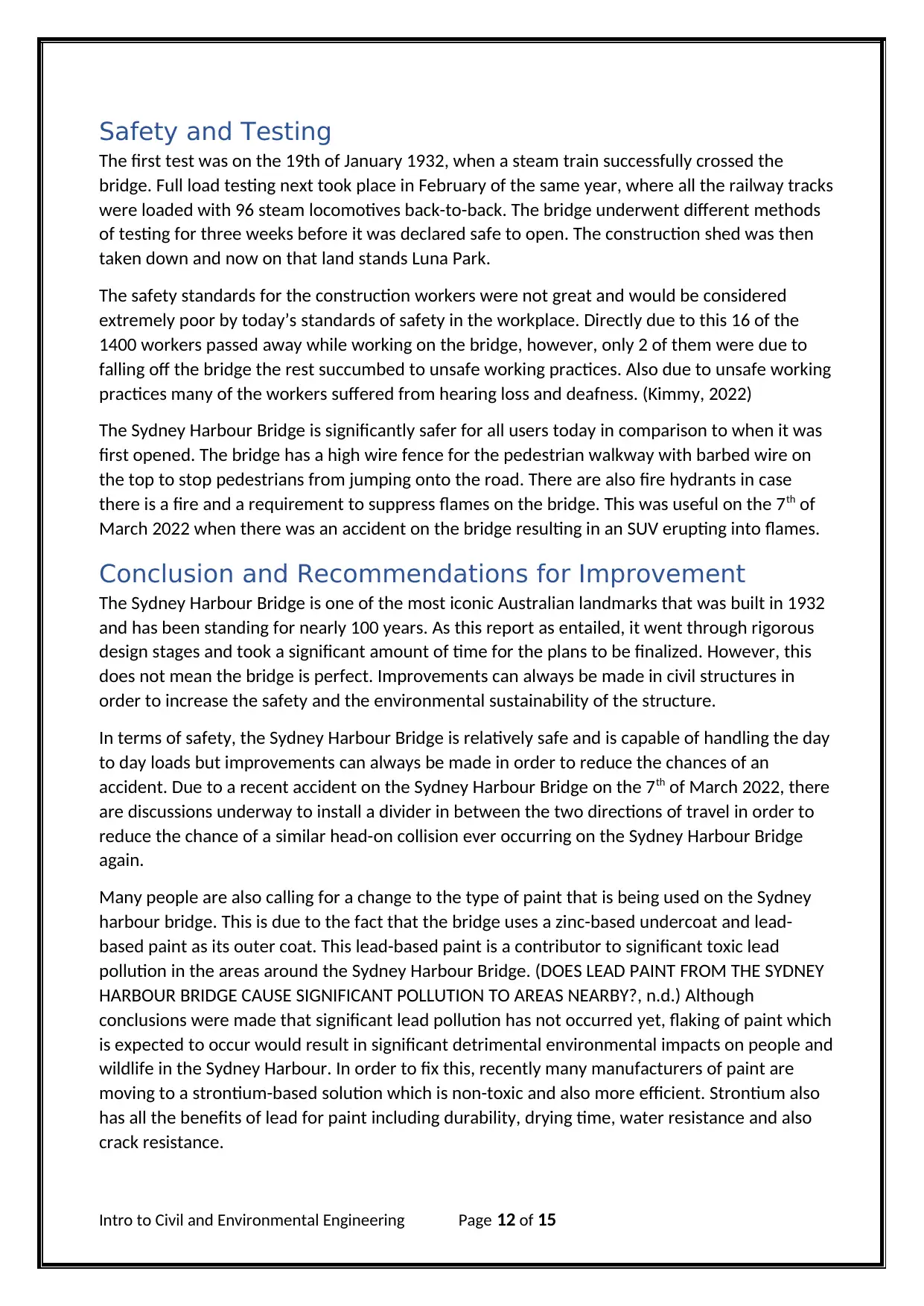
Safety and Testing
The first test was on the 19th of January 1932, when a steam train successfully crossed the
bridge. Full load testing next took place in February of the same year, where all the railway tracks
were loaded with 96 steam locomotives back-to-back. The bridge underwent different methods
of testing for three weeks before it was declared safe to open. The construction shed was then
taken down and now on that land stands Luna Park.
The safety standards for the construction workers were not great and would be considered
extremely poor by today’s standards of safety in the workplace. Directly due to this 16 of the
1400 workers passed away while working on the bridge, however, only 2 of them were due to
falling off the bridge the rest succumbed to unsafe working practices. Also due to unsafe working
practices many of the workers suffered from hearing loss and deafness. (Kimmy, 2022)
The Sydney Harbour Bridge is significantly safer for all users today in comparison to when it was
first opened. The bridge has a high wire fence for the pedestrian walkway with barbed wire on
the top to stop pedestrians from jumping onto the road. There are also fire hydrants in case
there is a fire and a requirement to suppress flames on the bridge. This was useful on the 7th of
March 2022 when there was an accident on the bridge resulting in an SUV erupting into flames.
Conclusion and Recommendations for Improvement
The Sydney Harbour Bridge is one of the most iconic Australian landmarks that was built in 1932
and has been standing for nearly 100 years. As this report as entailed, it went through rigorous
design stages and took a significant amount of time for the plans to be finalized. However, this
does not mean the bridge is perfect. Improvements can always be made in civil structures in
order to increase the safety and the environmental sustainability of the structure.
In terms of safety, the Sydney Harbour Bridge is relatively safe and is capable of handling the day
to day loads but improvements can always be made in order to reduce the chances of an
accident. Due to a recent accident on the Sydney Harbour Bridge on the 7th of March 2022, there
are discussions underway to install a divider in between the two directions of travel in order to
reduce the chance of a similar head-on collision ever occurring on the Sydney Harbour Bridge
again.
Many people are also calling for a change to the type of paint that is being used on the Sydney
harbour bridge. This is due to the fact that the bridge uses a zinc-based undercoat and lead-
based paint as its outer coat. This lead-based paint is a contributor to significant toxic lead
pollution in the areas around the Sydney Harbour Bridge. (DOES LEAD PAINT FROM THE SYDNEY
HARBOUR BRIDGE CAUSE SIGNIFICANT POLLUTION TO AREAS NEARBY?, n.d.) Although
conclusions were made that significant lead pollution has not occurred yet, flaking of paint which
is expected to occur would result in significant detrimental environmental impacts on people and
wildlife in the Sydney Harbour. In order to fix this, recently many manufacturers of paint are
moving to a strontium-based solution which is non-toxic and also more efficient. Strontium also
has all the benefits of lead for paint including durability, drying time, water resistance and also
crack resistance.
Intro to Civil and Environmental Engineering Page 12 of 15
The first test was on the 19th of January 1932, when a steam train successfully crossed the
bridge. Full load testing next took place in February of the same year, where all the railway tracks
were loaded with 96 steam locomotives back-to-back. The bridge underwent different methods
of testing for three weeks before it was declared safe to open. The construction shed was then
taken down and now on that land stands Luna Park.
The safety standards for the construction workers were not great and would be considered
extremely poor by today’s standards of safety in the workplace. Directly due to this 16 of the
1400 workers passed away while working on the bridge, however, only 2 of them were due to
falling off the bridge the rest succumbed to unsafe working practices. Also due to unsafe working
practices many of the workers suffered from hearing loss and deafness. (Kimmy, 2022)
The Sydney Harbour Bridge is significantly safer for all users today in comparison to when it was
first opened. The bridge has a high wire fence for the pedestrian walkway with barbed wire on
the top to stop pedestrians from jumping onto the road. There are also fire hydrants in case
there is a fire and a requirement to suppress flames on the bridge. This was useful on the 7th of
March 2022 when there was an accident on the bridge resulting in an SUV erupting into flames.
Conclusion and Recommendations for Improvement
The Sydney Harbour Bridge is one of the most iconic Australian landmarks that was built in 1932
and has been standing for nearly 100 years. As this report as entailed, it went through rigorous
design stages and took a significant amount of time for the plans to be finalized. However, this
does not mean the bridge is perfect. Improvements can always be made in civil structures in
order to increase the safety and the environmental sustainability of the structure.
In terms of safety, the Sydney Harbour Bridge is relatively safe and is capable of handling the day
to day loads but improvements can always be made in order to reduce the chances of an
accident. Due to a recent accident on the Sydney Harbour Bridge on the 7th of March 2022, there
are discussions underway to install a divider in between the two directions of travel in order to
reduce the chance of a similar head-on collision ever occurring on the Sydney Harbour Bridge
again.
Many people are also calling for a change to the type of paint that is being used on the Sydney
harbour bridge. This is due to the fact that the bridge uses a zinc-based undercoat and lead-
based paint as its outer coat. This lead-based paint is a contributor to significant toxic lead
pollution in the areas around the Sydney Harbour Bridge. (DOES LEAD PAINT FROM THE SYDNEY
HARBOUR BRIDGE CAUSE SIGNIFICANT POLLUTION TO AREAS NEARBY?, n.d.) Although
conclusions were made that significant lead pollution has not occurred yet, flaking of paint which
is expected to occur would result in significant detrimental environmental impacts on people and
wildlife in the Sydney Harbour. In order to fix this, recently many manufacturers of paint are
moving to a strontium-based solution which is non-toxic and also more efficient. Strontium also
has all the benefits of lead for paint including durability, drying time, water resistance and also
crack resistance.
Intro to Civil and Environmental Engineering Page 12 of 15

Intro to Civil and Environmental Engineering Page 13 of 15
Paraphrase This Document
Need a fresh take? Get an instant paraphrase of this document with our AI Paraphraser
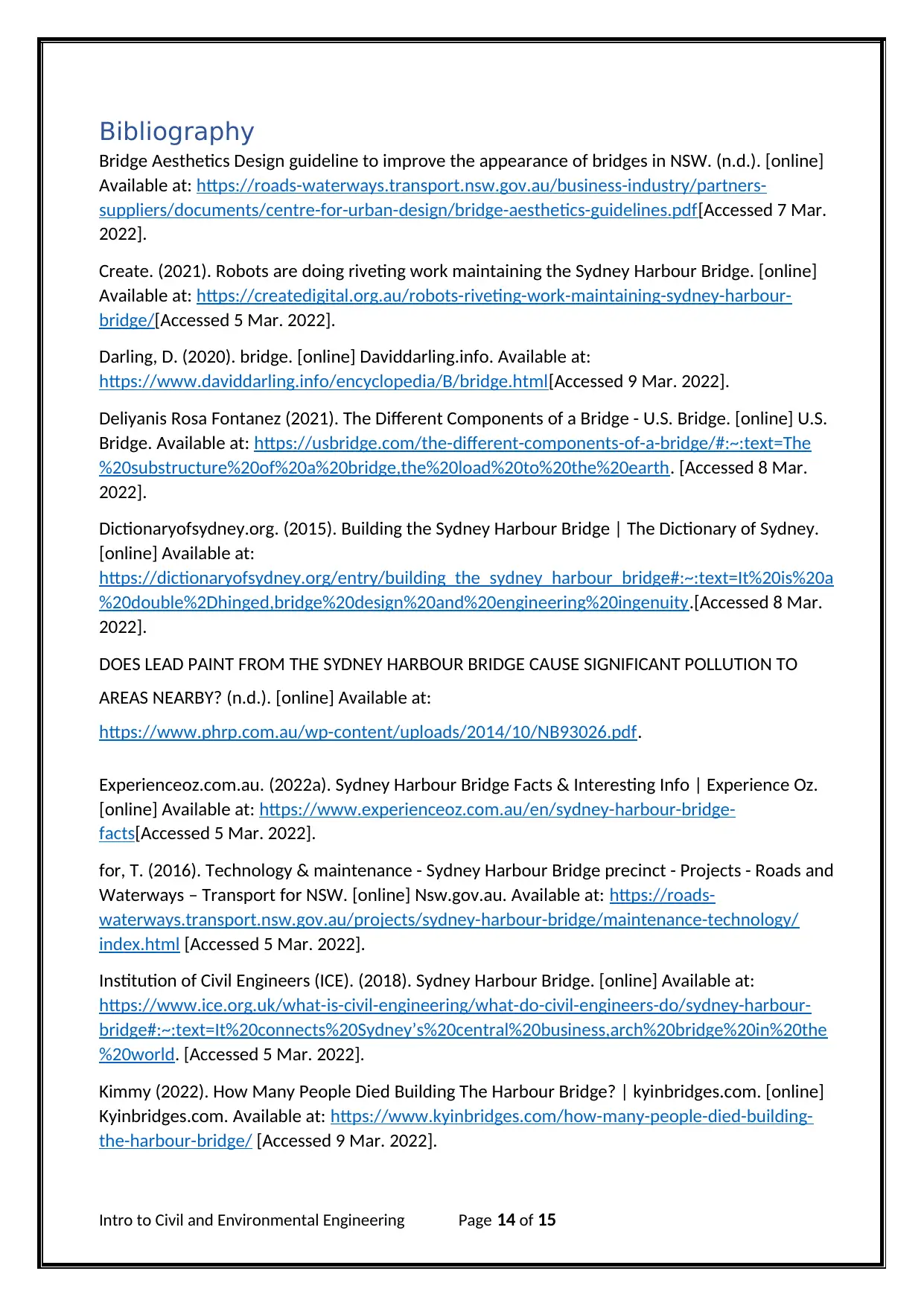
Bibliography
Bridge Aesthetics Design guideline to improve the appearance of bridges in NSW. (n.d.). [online]
Available at: https://roads-waterways.transport.nsw.gov.au/business-industry/partners-
suppliers/documents/centre-for-urban-design/bridge-aesthetics-guidelines.pdf[Accessed 7 Mar.
2022].
Create. (2021). Robots are doing riveting work maintaining the Sydney Harbour Bridge. [online]
Available at: https://createdigital.org.au/robots-riveting-work-maintaining-sydney-harbour-
bridge/[Accessed 5 Mar. 2022].
Darling, D. (2020). bridge. [online] Daviddarling.info. Available at:
https://www.daviddarling.info/encyclopedia/B/bridge.html[Accessed 9 Mar. 2022].
Deliyanis Rosa Fontanez (2021). The Different Components of a Bridge - U.S. Bridge. [online] U.S.
Bridge. Available at: https://usbridge.com/the-different-components-of-a-bridge/#:~:text=The
%20substructure%20of%20a%20bridge,the%20load%20to%20the%20earth. [Accessed 8 Mar.
2022].
Dictionaryofsydney.org. (2015). Building the Sydney Harbour Bridge | The Dictionary of Sydney.
[online] Available at:
https://dictionaryofsydney.org/entry/building_the_sydney_harbour_bridge#:~:text=It%20is%20a
%20double%2Dhinged,bridge%20design%20and%20engineering%20ingenuity.[Accessed 8 Mar.
2022].
DOES LEAD PAINT FROM THE SYDNEY HARBOUR BRIDGE CAUSE SIGNIFICANT POLLUTION TO
AREAS NEARBY? (n.d.). [online] Available at:
https://www.phrp.com.au/wp-content/uploads/2014/10/NB93026.pdf.
Experienceoz.com.au. (2022a). Sydney Harbour Bridge Facts & Interesting Info | Experience Oz.
[online] Available at: https://www.experienceoz.com.au/en/sydney-harbour-bridge-
facts[Accessed 5 Mar. 2022].
for, T. (2016). Technology & maintenance - Sydney Harbour Bridge precinct - Projects - Roads and
Waterways – Transport for NSW. [online] Nsw.gov.au. Available at: https://roads-
waterways.transport.nsw.gov.au/projects/sydney-harbour-bridge/maintenance-technology/
index.html [Accessed 5 Mar. 2022].
Institution of Civil Engineers (ICE). (2018). Sydney Harbour Bridge. [online] Available at:
https://www.ice.org.uk/what-is-civil-engineering/what-do-civil-engineers-do/sydney-harbour-
bridge#:~:text=It%20connects%20Sydney’s%20central%20business,arch%20bridge%20in%20the
%20world. [Accessed 5 Mar. 2022].
Kimmy (2022). How Many People Died Building The Harbour Bridge? | kyinbridges.com. [online]
Kyinbridges.com. Available at: https://www.kyinbridges.com/how-many-people-died-building-
the-harbour-bridge/ [Accessed 9 Mar. 2022].
Intro to Civil and Environmental Engineering Page 14 of 15
Bridge Aesthetics Design guideline to improve the appearance of bridges in NSW. (n.d.). [online]
Available at: https://roads-waterways.transport.nsw.gov.au/business-industry/partners-
suppliers/documents/centre-for-urban-design/bridge-aesthetics-guidelines.pdf[Accessed 7 Mar.
2022].
Create. (2021). Robots are doing riveting work maintaining the Sydney Harbour Bridge. [online]
Available at: https://createdigital.org.au/robots-riveting-work-maintaining-sydney-harbour-
bridge/[Accessed 5 Mar. 2022].
Darling, D. (2020). bridge. [online] Daviddarling.info. Available at:
https://www.daviddarling.info/encyclopedia/B/bridge.html[Accessed 9 Mar. 2022].
Deliyanis Rosa Fontanez (2021). The Different Components of a Bridge - U.S. Bridge. [online] U.S.
Bridge. Available at: https://usbridge.com/the-different-components-of-a-bridge/#:~:text=The
%20substructure%20of%20a%20bridge,the%20load%20to%20the%20earth. [Accessed 8 Mar.
2022].
Dictionaryofsydney.org. (2015). Building the Sydney Harbour Bridge | The Dictionary of Sydney.
[online] Available at:
https://dictionaryofsydney.org/entry/building_the_sydney_harbour_bridge#:~:text=It%20is%20a
%20double%2Dhinged,bridge%20design%20and%20engineering%20ingenuity.[Accessed 8 Mar.
2022].
DOES LEAD PAINT FROM THE SYDNEY HARBOUR BRIDGE CAUSE SIGNIFICANT POLLUTION TO
AREAS NEARBY? (n.d.). [online] Available at:
https://www.phrp.com.au/wp-content/uploads/2014/10/NB93026.pdf.
Experienceoz.com.au. (2022a). Sydney Harbour Bridge Facts & Interesting Info | Experience Oz.
[online] Available at: https://www.experienceoz.com.au/en/sydney-harbour-bridge-
facts[Accessed 5 Mar. 2022].
for, T. (2016). Technology & maintenance - Sydney Harbour Bridge precinct - Projects - Roads and
Waterways – Transport for NSW. [online] Nsw.gov.au. Available at: https://roads-
waterways.transport.nsw.gov.au/projects/sydney-harbour-bridge/maintenance-technology/
index.html [Accessed 5 Mar. 2022].
Institution of Civil Engineers (ICE). (2018). Sydney Harbour Bridge. [online] Available at:
https://www.ice.org.uk/what-is-civil-engineering/what-do-civil-engineers-do/sydney-harbour-
bridge#:~:text=It%20connects%20Sydney’s%20central%20business,arch%20bridge%20in%20the
%20world. [Accessed 5 Mar. 2022].
Kimmy (2022). How Many People Died Building The Harbour Bridge? | kyinbridges.com. [online]
Kyinbridges.com. Available at: https://www.kyinbridges.com/how-many-people-died-building-
the-harbour-bridge/ [Accessed 9 Mar. 2022].
Intro to Civil and Environmental Engineering Page 14 of 15
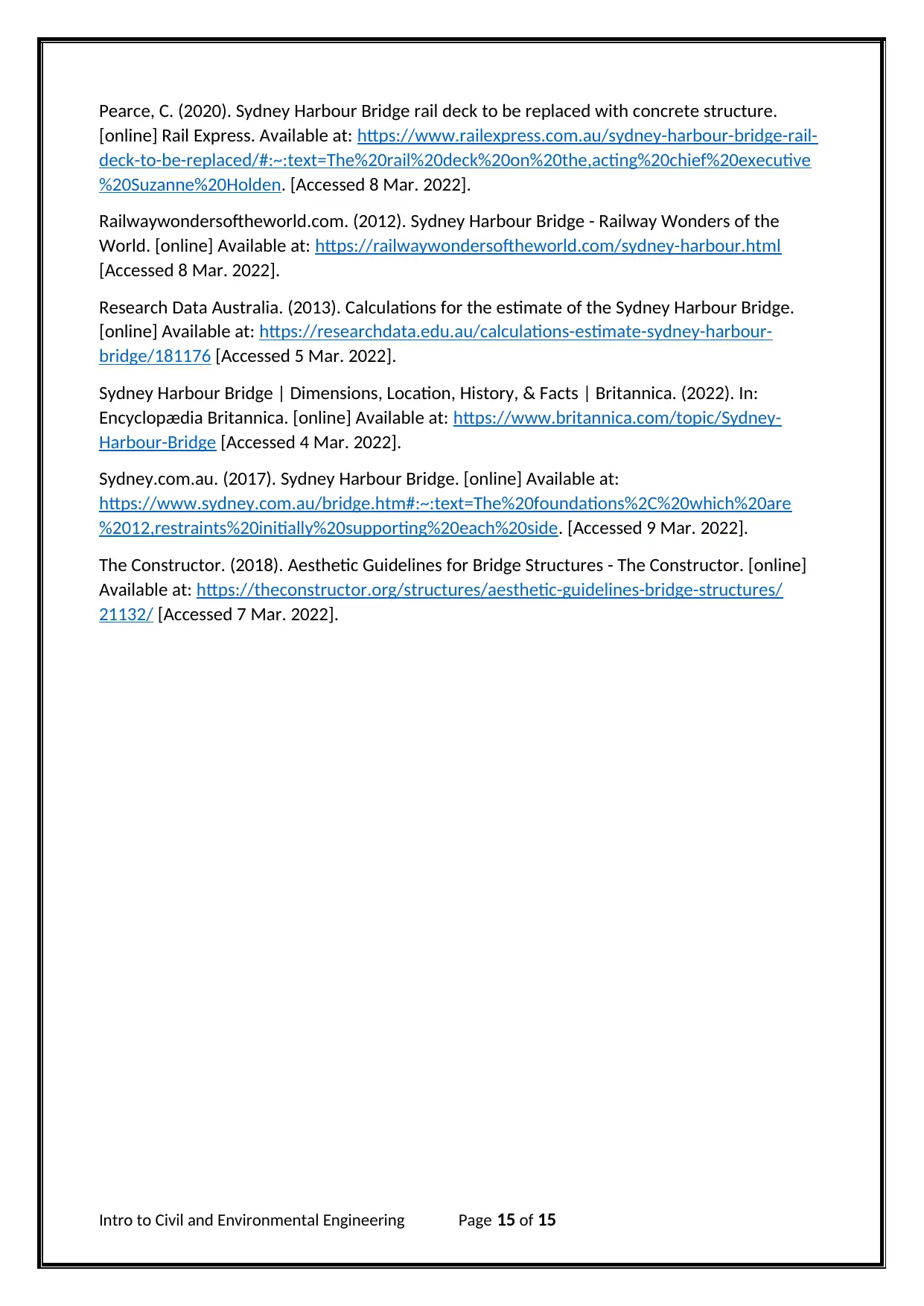
Pearce, C. (2020). Sydney Harbour Bridge rail deck to be replaced with concrete structure.
[online] Rail Express. Available at: https://www.railexpress.com.au/sydney-harbour-bridge-rail-
deck-to-be-replaced/#:~:text=The%20rail%20deck%20on%20the,acting%20chief%20executive
%20Suzanne%20Holden. [Accessed 8 Mar. 2022].
Railwaywondersoftheworld.com. (2012). Sydney Harbour Bridge - Railway Wonders of the
World. [online] Available at: https://railwaywondersoftheworld.com/sydney-harbour.html
[Accessed 8 Mar. 2022].
Research Data Australia. (2013). Calculations for the estimate of the Sydney Harbour Bridge.
[online] Available at: https://researchdata.edu.au/calculations-estimate-sydney-harbour-
bridge/181176 [Accessed 5 Mar. 2022].
Sydney Harbour Bridge | Dimensions, Location, History, & Facts | Britannica. (2022). In:
Encyclopædia Britannica. [online] Available at: https://www.britannica.com/topic/Sydney-
Harbour-Bridge [Accessed 4 Mar. 2022].
Sydney.com.au. (2017). Sydney Harbour Bridge. [online] Available at:
https://www.sydney.com.au/bridge.htm#:~:text=The%20foundations%2C%20which%20are
%2012,restraints%20initially%20supporting%20each%20side. [Accessed 9 Mar. 2022].
The Constructor. (2018). Aesthetic Guidelines for Bridge Structures - The Constructor. [online]
Available at: https://theconstructor.org/structures/aesthetic-guidelines-bridge-structures/
21132/ [Accessed 7 Mar. 2022].
Intro to Civil and Environmental Engineering Page 15 of 15
[online] Rail Express. Available at: https://www.railexpress.com.au/sydney-harbour-bridge-rail-
deck-to-be-replaced/#:~:text=The%20rail%20deck%20on%20the,acting%20chief%20executive
%20Suzanne%20Holden. [Accessed 8 Mar. 2022].
Railwaywondersoftheworld.com. (2012). Sydney Harbour Bridge - Railway Wonders of the
World. [online] Available at: https://railwaywondersoftheworld.com/sydney-harbour.html
[Accessed 8 Mar. 2022].
Research Data Australia. (2013). Calculations for the estimate of the Sydney Harbour Bridge.
[online] Available at: https://researchdata.edu.au/calculations-estimate-sydney-harbour-
bridge/181176 [Accessed 5 Mar. 2022].
Sydney Harbour Bridge | Dimensions, Location, History, & Facts | Britannica. (2022). In:
Encyclopædia Britannica. [online] Available at: https://www.britannica.com/topic/Sydney-
Harbour-Bridge [Accessed 4 Mar. 2022].
Sydney.com.au. (2017). Sydney Harbour Bridge. [online] Available at:
https://www.sydney.com.au/bridge.htm#:~:text=The%20foundations%2C%20which%20are
%2012,restraints%20initially%20supporting%20each%20side. [Accessed 9 Mar. 2022].
The Constructor. (2018). Aesthetic Guidelines for Bridge Structures - The Constructor. [online]
Available at: https://theconstructor.org/structures/aesthetic-guidelines-bridge-structures/
21132/ [Accessed 7 Mar. 2022].
Intro to Civil and Environmental Engineering Page 15 of 15
1 out of 15
Your All-in-One AI-Powered Toolkit for Academic Success.
+13062052269
info@desklib.com
Available 24*7 on WhatsApp / Email
![[object Object]](/_next/static/media/star-bottom.7253800d.svg)
Unlock your academic potential
© 2024 | Zucol Services PVT LTD | All rights reserved.